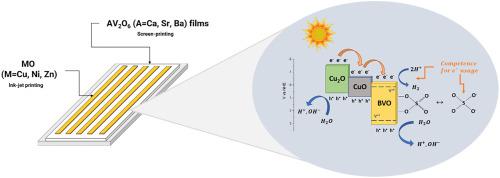International Journal of Hydrogen Energy ( IF 8.1 ) Pub Date : 2021-09-24 , DOI: 10.1016/j.ijhydene.2021.09.007 A. Aguirre-Astrain 1 , E. Luévano-Hipólito 2 , L.M. Torres-Martínez 1, 3

|
The non-polluting nature of photocatalytic H2 production makes of interest the study of semiconductors for this process. Scale-up of the photocatalytic hydrogen process to a pilot plant requires the photocatalyst's immobilization to enhance the charge transfer and facilitate its recovery. In this work, screen-printed films from the AV2O6 (A = Ca, Sr, Ba) semiconductor family were fabricated and evaluated in photocatalytic water splitting for H2 production in distilled water and seawater under UVA light. The films exhibited ∼3.1 eV band gaps, high crystallinity, and heterogeneous morphologies. BaV2O6 film exhibited the highest H2 production in distilled water (691 μmol/g), related to the synergistic effect between a higher crystallinity and traces of V+4 species that decrease the recombination of the photogenerated charges. Also, to take advantage of the dissolved species in seawater that could act as sacrificial agents, the BaV2O6 film was evaluated in seawater, in which H2 production was up to 6 times higher (4374 μmol/g) than in distilled water. The BaV2O6 film was decorated with simple oxides (CuO, NiO, and ZnO) by the ink-jet printing technology to increase its photocatalytic performance for H2 production. The highest efficiency with distilled water was obtained with the BaV2O6-CuO film, which reached an H2 production up to 30 times higher than the bare BaV2O6, own to the n-p heterostructure formation that enhances the charge transport in the photocatalytic process. When the BaV2O6-CuO film was evaluated in seawater, a more constant H2 production was observed; moreover, the efficiency was similar compared to the production in distilled water (20,563 μmol/g). To elucidate the seawater compounds that most influence the H2 production, a two levels Plackett–Burman experiments design was carried out in simulated seawater. The analysis revealed that the SO42− ions from the CaSO4 could be decreasing the H2 production by acting as Lewis's acid sites that trap the photogenerated e− competing for its usage with the H+. Additionally, the Cl− ions and the HCO3− reduction improved the HCOOH production from simulated seawater, reaching 26 times a higher production (23,333 μmol/g) than in distilled water.
中文翻译:

将用于 AV2O6(A=Ca、Sr、Ba)-MO(M=Cu、Ni、Zn)光催化剂制造的 2D 打印技术集成到使用海水生产太阳能燃料
光催化 H 2生产的无污染性质使该过程的半导体研究引起了人们的兴趣。将光催化制氢工艺扩大到中试工厂需要固定光催化剂以增强电荷转移并促进其回收。在这项工作中,制造了来自 AV 2 O 6 (A = Ca、Sr、Ba) 半导体系列的丝网印刷薄膜,并在 UVA 光下在蒸馏水和海水中的光催化水分解中评估了 H 2生产。该薄膜表现出约 3.1 eV 的带隙、高结晶度和异质形态。BaV 2 O 6薄膜表现出最高的H 2在蒸馏水 (691 μmol/g) 中产生,与较高结晶度和痕量 V +4物种之间的协同效应有关,这些 V +4物种减少了光生电荷的复合。此外,为了利用可作为牺牲剂的海水中的溶解物质,在海水中评估BaV 2 O 6膜,其中 H 2 的产生量比蒸馏水高 6 倍(4374 μmol/g) . BaV 2 O 6薄膜通过喷墨印刷技术用简单的氧化物(CuO、NiO和ZnO)装饰,以提高其对H 2 的光催化性能。BaV 使用蒸馏水获得最高效率2 O 6 -CuO 膜的 H 2产量比裸 BaV 2 O 6高出 30 倍,具有 np 异质结构形成,增强了光催化过程中的电荷传输。当在海水中评估BaV 2 O 6 -CuO 膜时,观察到更稳定的 H 2生成;此外,与在蒸馏水中的产量 (20,563 μmol/g) 相比,效率相似。为了阐明对 H 2产生影响最大的海水化合物,在模拟海水中进行了两级 Plackett-Burman 实验设计。分析表明,SO 4 2-来自 CaSO 4 的离子可以通过充当路易斯酸位点来捕获光生 e -与 H +竞争其使用,从而减少 H 2 的产生。此外,Cl -离子和 HCO 3 -还原提高了模拟海水中 HCOOH 的产量,其产量 (23,333 μmol/g) 是蒸馏水中的 26 倍。









































 京公网安备 11010802027423号
京公网安备 11010802027423号